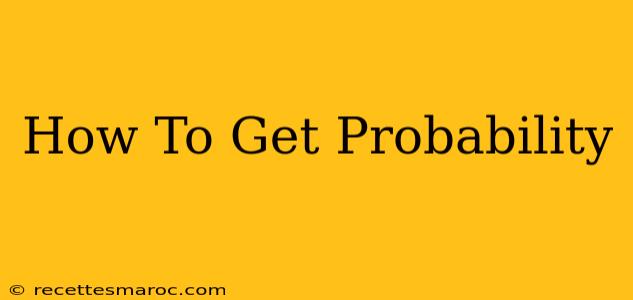Understanding probability might seem daunting at first, but it's a fundamental concept with applications in many areas of life, from everyday decision-making to advanced scientific research. This guide breaks down how to get probability, covering basic concepts and practical examples.
What is Probability?
Probability measures the likelihood of an event occurring. It's expressed as a number between 0 and 1, where:
- 0 means the event is impossible.
- 1 means the event is certain.
- Values between 0 and 1 represent the likelihood of the event happening, with higher values indicating a greater chance.
For example, the probability of flipping a fair coin and getting heads is 0.5 (or 50%), because there are two equally likely outcomes (heads or tails).
Calculating Probability: The Basics
The basic formula for probability is:
Probability (Event) = (Number of Favorable Outcomes) / (Total Number of Possible Outcomes)
Let's illustrate this with some examples:
Example 1: Rolling a Dice
What's the probability of rolling a 3 on a six-sided die?
- Number of Favorable Outcomes: 1 (only one face shows a 3)
- Total Number of Possible Outcomes: 6 (six faces in total)
Probability (rolling a 3) = 1/6
Example 2: Drawing a Card
What's the probability of drawing a King from a standard deck of 52 cards?
- Number of Favorable Outcomes: 4 (four Kings in the deck)
- Total Number of Possible Outcomes: 52 (total cards in the deck)
Probability (drawing a King) = 4/52 = 1/13
Types of Probability
Understanding different types of probability helps in various scenarios:
1. Theoretical Probability: This is calculated based on logical reasoning and assumptions about the event. The coin flip and dice roll examples above are examples of theoretical probability.
2. Experimental Probability: This is determined by conducting experiments and observing the outcomes. For instance, if you flip a coin 100 times and get heads 48 times, the experimental probability of getting heads is 48/100 = 0.48. This can differ from theoretical probability due to randomness.
3. Subjective Probability: This relies on personal judgment and beliefs, often used when precise calculations aren't possible. For instance, estimating the probability of a specific company's stock price increasing involves subjective probability.
Beyond the Basics: More Complex Scenarios
Calculating probability can become more complex when dealing with:
- Dependent Events: Events where the outcome of one affects the probability of the other (e.g., drawing two cards without replacement).
- Independent Events: Events where the outcome of one doesn't affect the other (e.g., flipping a coin twice).
- Conditional Probability: The probability of an event occurring given that another event has already occurred (often denoted as P(A|B), read as "probability of A given B").
Mastering Probability: Resources and Practice
To truly master probability, consistent practice is key. Work through various problems, starting with simple ones and gradually increasing the difficulty. Online resources, textbooks, and educational websites offer numerous problems and explanations to aid in your learning.
By understanding the fundamental concepts and applying the basic formula, you'll be well on your way to confidently tackling probability problems in various contexts. Remember that practice makes perfect!

